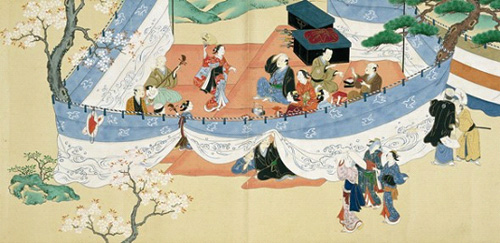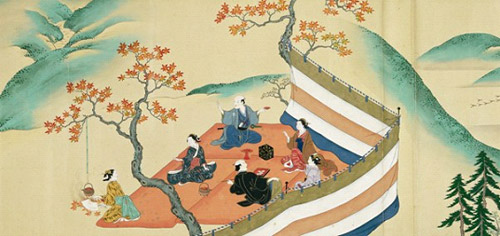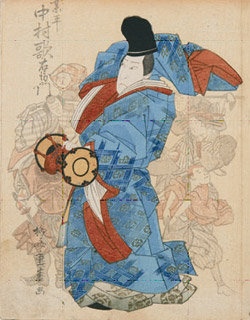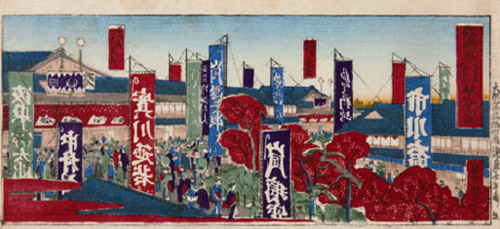
(1) Genre Scenes in the Four Seasons
Nishikawa Sukenobu
During the Kyoho era (1716-1736): Collection of Chiba City Museum of Art

Scene of spring (partying under cherry blossoms) from the Genre Scenes in the Four Seasons
*This part will be exhibited during the first half of the exhibition period (April 19 to May 6).

Scene of autumn (outing to view tinted leaves) from the Genre Scenes in the Four Seasons
*This part will be exhibited during the second half of the exhibition period (May 8 to June 1).
(2) Daisho-goyomi Calendar of the Year of the Monkey
Urakusai Nagahide
1836: Private collection

Daisho-goyomi is a one-sheet illustrated lunar calendar. As this is a calendar of the year of the monkey, a monkey wearing a crown and carrying paper strips, to mimic a performer of a celebratory dance called Sanbasou, is depicted in the lower part. The large Chinese characters at the center mean “watch out for fire” which indicates that this calendar was posted in a kitchen or other space where fire was used, suggesting that ukiyo-e was part of everyday life of ordinary people. Urakusai Nagahide was active as an ukiyo-e artist in Kyoto and Osaka in the late Edo period.
(3) Nakamura Utaemon IV as Narihira
Ryusai Shigeharu
1838: Private collection of Mr. Yamamura Waka,
the 6th master of the Yamamura School of Kamigata-mai dance

This ukiyo-e print portrays a kabuki actor, Nakamura Utaemon IV, playing Narihira in January 1838 at Dotonbori in Osaka before his trip to Edo. This work is characterized by the generous use of paints and the sophisticated design technique of highlighting the subject against a light background, as well as the absence of the seal of the publisher, suggesting that this print was created not for sale but to distribute among fans. This work is very popular overseas, while very few prints exist in Japan.
(4) Prosperity of Kabuki and Joruri Puppet Theaters
in the Matsushima Kuruwa Pleasure District
Ichiyotei Yoshitaki
1872-76: Private collection
Matsushima Kuruwa was opened in 1869 as a government-permitted pleasure district to replace the Shinmachi Kuruwa, in a newly developed estuary area sandwiched between the Kizu River and Shirinashi River. With the addition of the Bunraku-za joruri puppet theater and the Matsushima-za kabuki theater, this district became very popular also among theatergoers. In this work, Ichiyotei Yoshitaki, an ukiyo-e artist active in Osaka, vividly depicted the prosperity of this district.


This is the work of Nishikawa Sukenobu (1671-1750), an artist active in Kyoto during the Edo period. This colorful handscroll depicts people of Kyoto enjoying seasonal recreational activities: partying under cherry blossoms in spring, having fun at the Shijo Riverside and going out to enjoy the cool evening in summer, honoring the full moon and going on an outing to view tinted leaves in autumn, and playing in snow in winter. Renowned also as a designer of patterns of kosode short-sleeved kimono, the artist finely depicted patterns of kimono and obi worn by women, which makes this work a valuable historical record of the fashion of those days. *Some of the exhibited works will be changed during the period of the exhibition.
*Some of the exhibited works will be changed during the period of the exhibition.